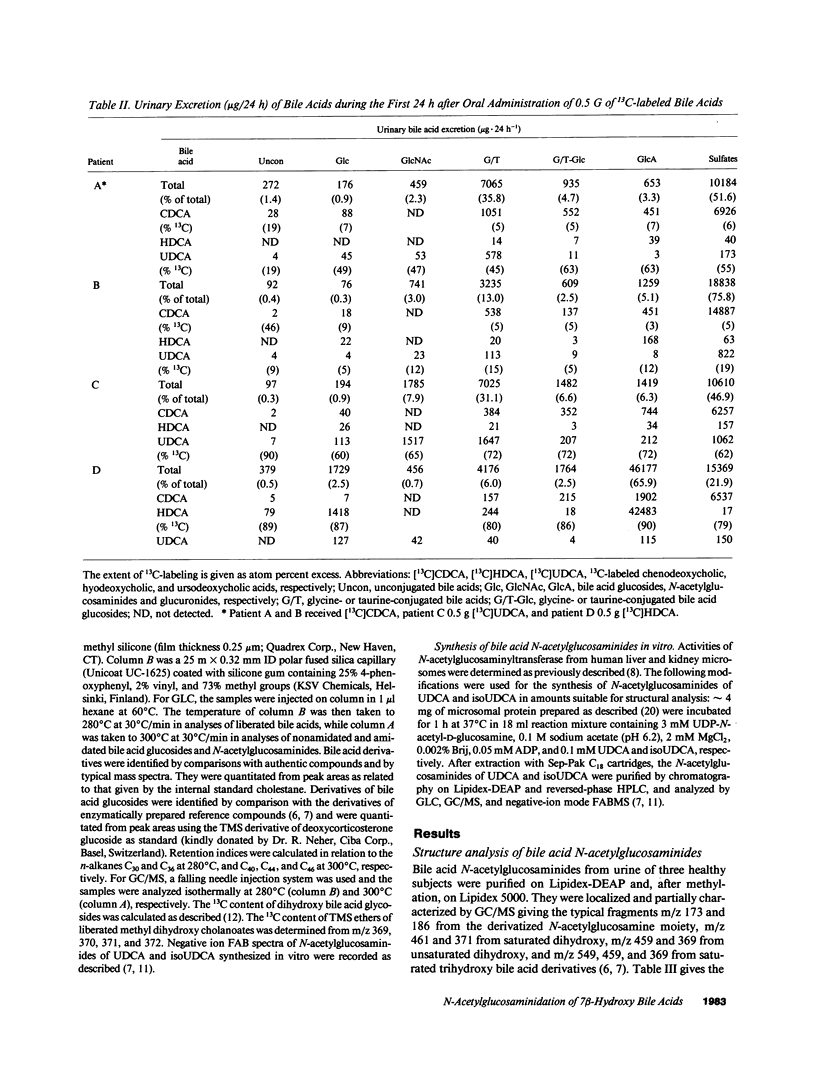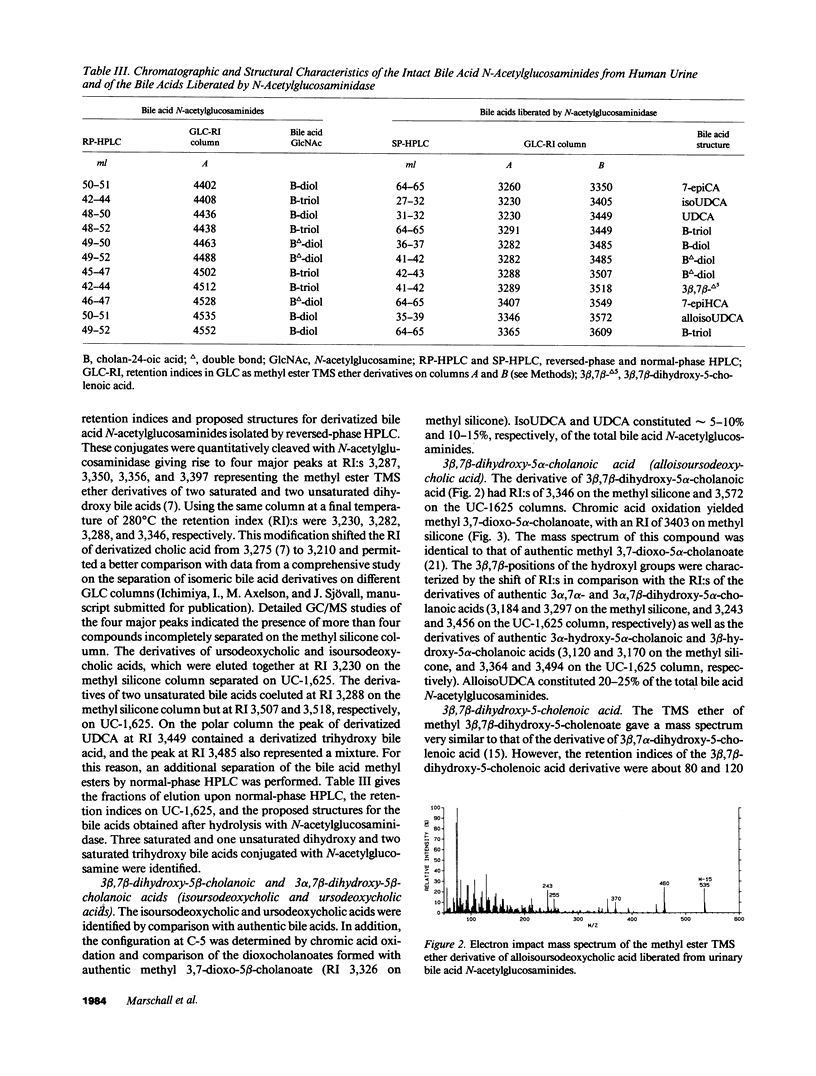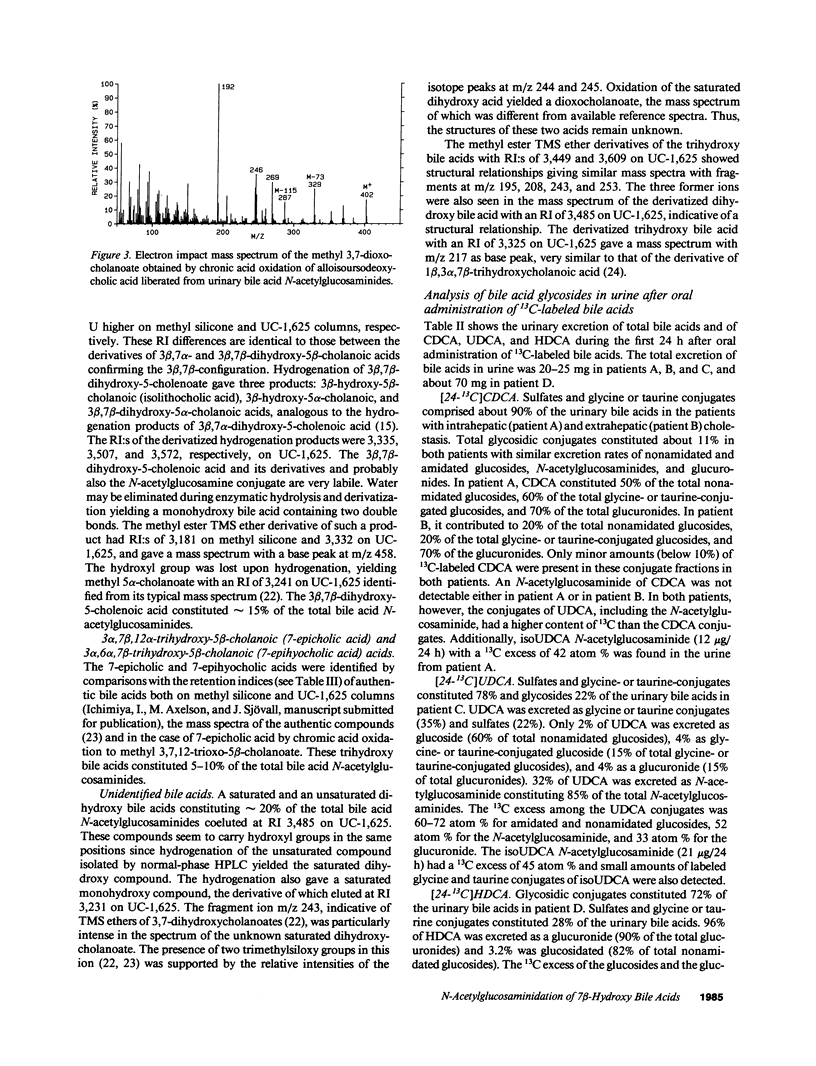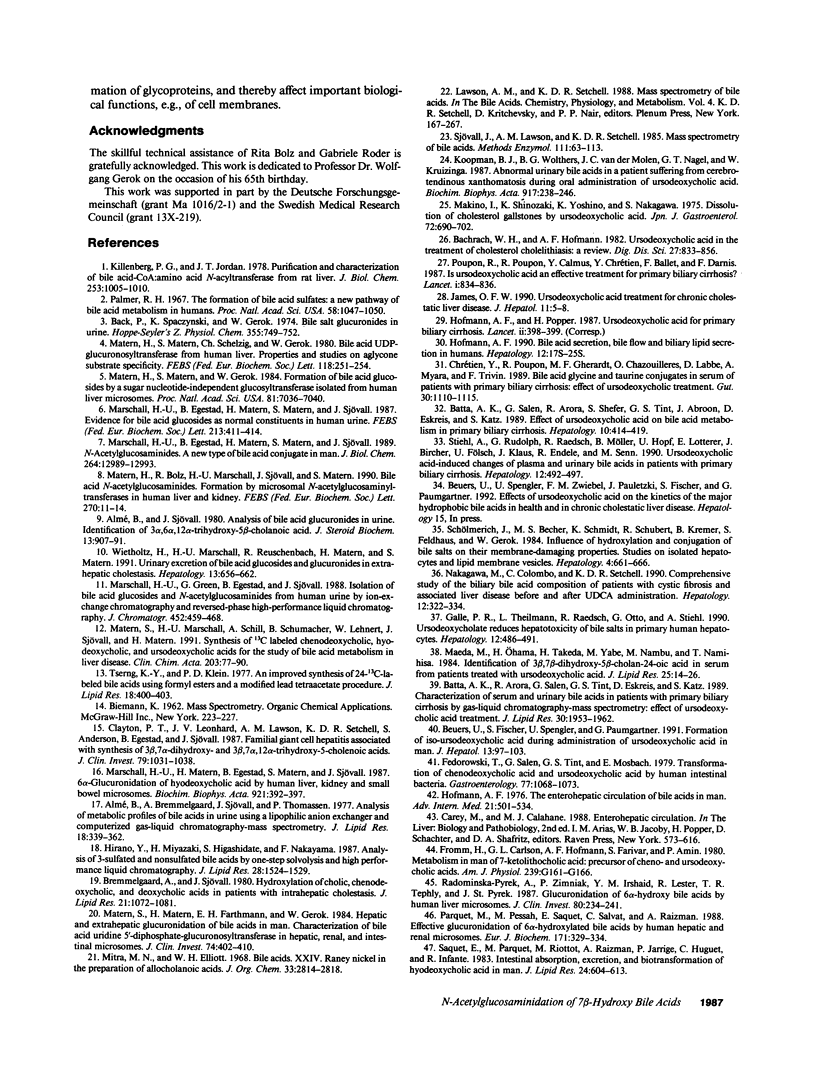Abstract
The aim of this study was to define whether N-acetylglucosaminidation is a selective conjugation pathway of structurally related bile acids in humans. The following bile acids released enzymatically from N-acetylglucosaminides were identified: 3 alpha,7 beta-dihydroxy-5 beta-cholanoic (ursodeoxycholic), 3 beta, 7 beta-dihydroxy-5 beta-cholanoic (isoursodeoxycholic), 3 beta,7 beta-dihydroxy-5 alpha-cholanoic (alloisoursodeoxycholic), 3 beta,7 beta-dihydroxy-5-cholenoic, 3 alpha,7 beta,12 alpha-trihydroxy-5 beta-cholanoic, and 3 alpha,6 alpha,7 beta-trihydroxy-5 beta-cholanoic acids. The selectivity of conjugation was studied by administration of 0.5 g ursodeoxycholic (UDCA) or hyodeoxycholic (HDCA) acids, labeled with 13C, to patients with extrahepatic cholestasis, and of 0.5 g of 13C-labeled chenodeoxycholic acid (CDCA) to patients with extra- or intrahepatic cholestasis. After administration of [24-13C]-CDCA, labeled glucosides, and the glucuronide of CDCA were excreted in similar amounts. Labeled N-acetylglucosaminides of UDCA and isoUDCA were also formed. When [24-13C]-UDCA was given, 13C-label was detected in the N-acetylglucosaminide, the glucosides, and the glucuronide of UDCA, and in the N-acetylglucosaminide of isoUDCA. In the patient studied, 32% of the total UDCA excreted in urine was conjugated with N-acetylglucosamine. In contrast, 96% of the excreted amount of [24-13C]HDCA was glucuronidated, and 13C-labeled glucosides but no N-acetylglucosaminide were detected. The selectivity of N-acetylglucosaminidation towards bile acids containing a 7 beta-hydroxyl group was confirmed in vitro using human liver and kidney microsomes and uridine diphosphate glucose (UDP)-N-acetylglucosamine. These studies show that N-acetylglucosaminidation is a selective conjugation pathway for 7 beta-hydroxylated bile acids.
Full text
PDF






Selected References
These references are in PubMed. This may not be the complete list of references from this article.
- Almé B., Bremmelgaard A., Sjövall J., Thomassen P. Analysis of metabolic profiles of bile acids in urine using a lipophilic anion exchanger and computerized gas-liquid chromatorgaphy-mass spectrometry. J Lipid Res. 1977 May;18(3):339–362. [PubMed] [Google Scholar]
- Almé B., Sjövall J. Analysis of bile acid glucuronides in urine. Identification of 3 alpha, 6 alpha, 12 alpha-trihydroxy-5 beta-cholanoic acid. J Steroid Biochem. 1980 Aug;13(8):907–916. doi: 10.1016/0022-4731(80)90164-8. [DOI] [PubMed] [Google Scholar]
- Bachrach W. H., Hofmann A. F. Ursodeoxycholic acid in the treatment of cholesterol cholelithiasis. Part II. Dig Dis Sci. 1982 Sep;27(9):833–856. doi: 10.1007/BF01391378. [DOI] [PubMed] [Google Scholar]
- Back P., Spaczynski K., Gerok W. Bile-salt glucuronides in urine. Hoppe Seylers Z Physiol Chem. 1974 Jun;355(6):749–752. [PubMed] [Google Scholar]
- Batta A. K., Arora R., Salen G., Tint G. S., Eskreis D., Katz S. Characterization of serum and urinary bile acids in patients with primary biliary cirrhosis by gas-liquid chromatography-mass spectrometry: effect of ursodeoxycholic acid treatment. J Lipid Res. 1989 Dec;30(12):1953–1962. [PubMed] [Google Scholar]
- Batta A. K., Salen G., Arora R., Shefer S., Tint G. S., Abroon J., Eskreis D., Katz S. Effect of ursodeoxycholic acid on bile acid metabolism in primary biliary cirrhosis. Hepatology. 1989 Oct;10(4):414–419. doi: 10.1002/hep.1840100404. [DOI] [PubMed] [Google Scholar]
- Beuers U., Fischer S., Spengler U., Paumgartner G. Formation of iso-ursodeoxycholic acid during administration of ursodeoxycholic acid in man. J Hepatol. 1991 Jul;13(1):97–103. doi: 10.1016/0168-8278(91)90870-h. [DOI] [PubMed] [Google Scholar]
- Bremmelgaard A., Sjövall J. Hydroxylation of cholic, chenodeoxycholic, and deoxycholic acids in patients with intrahepatic cholestasis. J Lipid Res. 1980 Nov;21(8):1072–1081. [PubMed] [Google Scholar]
- Chretien Y., Poupon R., Gherardt M. F., Chazouilleres O., Labbe D., Myara A., Trivin F. Bile acid glycine and taurine conjugates in serum of patients with primary biliary cirrhosis: effect of ursodeoxycholic treatment. Gut. 1989 Aug;30(8):1110–1115. doi: 10.1136/gut.30.8.1110. [DOI] [PMC free article] [PubMed] [Google Scholar]
- Clayton P. T., Leonard J. V., Lawson A. M., Setchell K. D., Andersson S., Egestad B., Sjövall J. Familial giant cell hepatitis associated with synthesis of 3 beta, 7 alpha-dihydroxy-and 3 beta,7 alpha, 12 alpha-trihydroxy-5-cholenoic acids. J Clin Invest. 1987 Apr;79(4):1031–1038. doi: 10.1172/JCI112915. [DOI] [PMC free article] [PubMed] [Google Scholar]
- Fedorowski T., Salen G., Tint G. S., Mosbach E. Transformation of chenodeoxycholic acid and ursodeoxycholic acid by human intestinal bacteria. Gastroenterology. 1979 Nov;77(5):1068–1073. [PubMed] [Google Scholar]
- Fromm H., Carlson G. L., Hofmann A. F., Farivar S., Amin P. Metabolism in man of 7-ketolithocholic acid: precursor of cheno- and ursodeoxycholic acids. Am J Physiol. 1980 Sep;239(3):G161–G166. doi: 10.1152/ajpgi.1980.239.3.G161. [DOI] [PubMed] [Google Scholar]
- Galle P. R., Theilmann L., Raedsch R., Otto G., Stiehl A. Ursodeoxycholate reduces hepatotoxicity of bile salts in primary human hepatocytes. Hepatology. 1990 Sep;12(3 Pt 1):486–491. doi: 10.1002/hep.1840120307. [DOI] [PubMed] [Google Scholar]
- Hirano Y., Miyazaki H., Higashidate S., Nakayama F. Analysis of 3-sulfated and nonsulfated bile acids by one-step solvolysis and high performance liquid chromatography. J Lipid Res. 1987 Dec;28(12):1524–1529. [PubMed] [Google Scholar]
- Hofmann A. F. Bile acid secretion, bile flow and biliary lipid secretion in humans. Hepatology. 1990 Sep;12(3 Pt 2):17S–25S. [PubMed] [Google Scholar]
- Hofmann A. F., Popper H. Ursodeoxycholic acid for primary biliary cirrhosis. Lancet. 1987 Aug 15;2(8555):398–399. doi: 10.1016/s0140-6736(87)92421-4. [DOI] [PubMed] [Google Scholar]
- Hofmann A. F. The enterohepatic circulation of bile acids in man. Adv Intern Med. 1976;21:501–534. [PubMed] [Google Scholar]
- James O. F. Ursodeoxycholic acid treatment for chronic cholestatic liver disease. J Hepatol. 1990 Jul;11(1):5–8. doi: 10.1016/0168-8278(90)90263-q. [DOI] [PubMed] [Google Scholar]
- Killenberg P. G., Jordan J. T. Purification and characterization of bile acid-CoA:amino acid N-acyltransferase from rat liver. J Biol Chem. 1978 Feb 25;253(4):1005–1010. [PubMed] [Google Scholar]
- Koopman B. J., Wolthers B. G., van der Molen J. C., Nagel G. T., Kruizinga W. Abnormal urinary bile acids in a patient suffering from cerebrotendinous xanthomatosis during oral administration of ursodeoxycholic acid. Biochim Biophys Acta. 1987 Feb 14;917(2):238–246. doi: 10.1016/0005-2760(87)90128-7. [DOI] [PubMed] [Google Scholar]
- Maeda M., Ohama H., Takeda H., Yabe M., Nambu M., Namihisa T. Identification of 3 beta, 7 beta-dihydroxy-5 beta-cholan-24-oic acid in serum from patients treated with ursodeoxycholic acid. J Lipid Res. 1984 Jan;25(1):14–26. [PubMed] [Google Scholar]
- Makino I., Shinozaki K., Yoshino K., Nakagawa S. [Dissolution of cholesterol gallstones by long-term administration of ursodeoxycholic acid]. Nihon Shokakibyo Gakkai Zasshi. 1975 Jun;72(6):690–702. [PubMed] [Google Scholar]
- Marschall H. U., Egestad B., Matern H., Matern S., Sjövall J. Evidence for bile acid glucosides as normal constituents in human urine. FEBS Lett. 1987 Mar 23;213(2):411–414. doi: 10.1016/0014-5793(87)81532-6. [DOI] [PubMed] [Google Scholar]
- Marschall H. U., Egestad B., Matern H., Matern S., Sjövall J. N-acetylglucosaminides. A new type of bile acid conjugate in man. J Biol Chem. 1989 Aug 5;264(22):12989–12993. [PubMed] [Google Scholar]
- Marschall H. U., Green G., Egestad B., Sjövall J. Isolation of bile acid glucosides and N-acetylglucosaminides from human urine by ion-exchange chromatography and reversed-phase high-performance liquid chromatography. J Chromatogr. 1988 Oct 28;452:459–468. doi: 10.1016/s0021-9673(01)81468-0. [DOI] [PubMed] [Google Scholar]
- Marschall H. U., Matern H., Egestad B., Matern S., Sjövall S. 6 alpha-glucuronidation of hyodeoxycholic acid by human liver, kidney and small bowel microsomes. Biochim Biophys Acta. 1987 Sep 25;921(2):392–397. doi: 10.1016/0005-2760(87)90041-5. [DOI] [PubMed] [Google Scholar]
- Matern H., Bolz R., Marschall H. U., Sjövall J., Matern S. Bile acid N-acetylglucosaminides. Formation by microsomal N-acetylglucosaminyltransferases in human liver and kidney. FEBS Lett. 1990 Sep 17;270(1-2):11–14. doi: 10.1016/0014-5793(90)81223-b. [DOI] [PubMed] [Google Scholar]
- Matern H., Matern S., Gerok W. Formation of bile acid glucosides by a sugar nucleotide-independent glucosyltransferase isolated from human liver microsomes. Proc Natl Acad Sci U S A. 1984 Nov;81(22):7036–7040. doi: 10.1073/pnas.81.22.7036. [DOI] [PMC free article] [PubMed] [Google Scholar]
- Matern H., Matern S., Schelzig C., Gerok W. Bile acid UDP-glucoronyltransferase from human liver. Properties and studies on aglycone substrate specificity. FEBS Lett. 1980 Sep 8;118(2):251–254. doi: 10.1016/0014-5793(80)80231-6. [DOI] [PubMed] [Google Scholar]
- Matern S., Marschall H. U., Schill A., Schumacher B., Lehnert W., Sjövall J., Matern H. Synthesis of 13C-labeled chenodeoxycholic, hyodeoxycholic, and ursodeoxycholic acids for the study of bile acid metabolism in liver disease. Clin Chim Acta. 1991 Nov 9;203(1):77–89. doi: 10.1016/0009-8981(91)90158-9. [DOI] [PubMed] [Google Scholar]
- Matern S., Matern H., Farthmann E. H., Gerok W. Hepatic and extrahepatic glucuronidation of bile acids in man. Characterization of bile acid uridine 5'-diphosphate-glucuronosyltransferase in hepatic, renal, and intestinal microsomes. J Clin Invest. 1984 Aug;74(2):402–410. doi: 10.1172/JCI111435. [DOI] [PMC free article] [PubMed] [Google Scholar]
- Mitra M. N., Elliott W. H. Bile acids. XXIV. Raney nickel in the preparation of allocholanic acids. J Org Chem. 1968 Jul;33(7):2814–2818. doi: 10.1021/jo01271a044. [DOI] [PubMed] [Google Scholar]
- Nakagawa M., Colombo C., Setchell K. D. Comprehensive study of the biliary bile acid composition of patients with cystic fibrosis and associated liver disease before and after UDCA administration. Hepatology. 1990 Aug;12(2):322–334. doi: 10.1002/hep.1840120221. [DOI] [PubMed] [Google Scholar]
- Palmer R. H. The formation of bile acid sulfates: a new pathway of bile acid metabolism in humans. Proc Natl Acad Sci U S A. 1967 Sep;58(3):1047–1050. doi: 10.1073/pnas.58.3.1047. [DOI] [PMC free article] [PubMed] [Google Scholar]
- Parquet M., Pessah M., Sacquet E., Salvat C., Raizman A. Effective glucuronidation of 6 alpha-hydroxylated bile acids by human hepatic and renal microsomes. Eur J Biochem. 1988 Jan 15;171(1-2):329–334. doi: 10.1111/j.1432-1033.1988.tb13794.x. [DOI] [PubMed] [Google Scholar]
- Poupon R., Chrétien Y., Poupon R. E., Ballet F., Calmus Y., Darnis F. Is ursodeoxycholic acid an effective treatment for primary biliary cirrhosis? Lancet. 1987 Apr 11;1(8537):834–836. doi: 10.1016/s0140-6736(87)91610-2. [DOI] [PubMed] [Google Scholar]
- Radomińska-Pyrek A., Zimniak P., Irshaid Y. M., Lester R., Tephly T. R., St Pyrek J. Glucuronidation of 6 alpha-hydroxy bile acids by human liver microsomes. J Clin Invest. 1987 Jul;80(1):234–241. doi: 10.1172/JCI113053. [DOI] [PMC free article] [PubMed] [Google Scholar]
- Sacquet E., Parquet M., Riottot M., Raizman A., Jarrige P., Huguet C., Infante R. Intestinal absorption, excretion, and biotransformation of hyodeoxycholic acid in man. J Lipid Res. 1983 May;24(5):604–613. [PubMed] [Google Scholar]
- Schölmerich J., Becher M. S., Schmidt K., Schubert R., Kremer B., Feldhaus S., Gerok W. Influence of hydroxylation and conjugation of bile salts on their membrane-damaging properties--studies on isolated hepatocytes and lipid membrane vesicles. Hepatology. 1984 Jul-Aug;4(4):661–666. doi: 10.1002/hep.1840040416. [DOI] [PubMed] [Google Scholar]
- Sjövall J., Lawson A. M., Setchell K. D. Mass spectrometry of bile acids. Methods Enzymol. 1985;111:63–113. doi: 10.1016/s0076-6879(85)11006-2. [DOI] [PubMed] [Google Scholar]
- Stiehl A., Rudolph G., Raedsch R., Möller B., Hopf U., Lotterer E., Bircher J., Fölsch U., Klaus J., Endele R. Ursodeoxycholic acid-induced changes of plasma and urinary bile acids in patients with primary biliary cirrhosis. Hepatology. 1990 Sep;12(3 Pt 1):492–497. doi: 10.1002/hep.1840120308. [DOI] [PubMed] [Google Scholar]
- Tserng K. Y., Klein P. D. An improved synthesis of 24-13C-labeled bile acids using formyl esters and a modified lead tetraacetate procedure. J Lipid Res. 1977 May;18(3):400–403. [PubMed] [Google Scholar]
- Wietholtz H., Marschall H. U., Reuschenbach R., Matern H., Matern S. Urinary excretion of bile acid glucosides and glucuronides in extrahepatic cholestasis. Hepatology. 1991 Apr;13(4):656–662. [PubMed] [Google Scholar]


